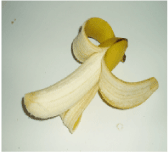Element:BSGFV
DescriptionBanana streak virus (BSV), the causal agent of viral "leaf streak disease" of banana and plantain (Musa spp.) (Lockhart, 1986), is a member of the plant pararetrovirus genus Badnavirus of family Caulimoviridae (International Committee on the Taxonomy of Viruses -ICTV- Fauquet et al. 2005). Several isolated have been studied, one of which is BSGFV infecting the tetraploid plantain hybrid cultivar "Goldfinger" (Zhang et al. 2003, unpublished). According to Llorens et al. 2009, BSGFV belongs to Badnavirus genus within Class 2 of the Caulimoviridae family. The bacilliform virions of BSGFV contain a circular dsDNA genome of about 7.3 kb in size (7263 bp long) which three Open reading frames (ORFs I, II, III) encode for proteins with a molecular weight of 19, 12.2 and 199.2 kDa, respectively. ORF I product shows sequence similarity with the virion associated protein (VAP) encoded by the correspondent ORF I of other Badnavirus species. ORF II encodes a small protein of unknown function, whereas ORF III contains a large polyprotein consisting of the putative movement protein, the coat protein, the aspartic protease, the reverse transcriptase and the RNase H (Zhang et al. 2003, unpublished). The COAT gag-like region includes a large region (only observed in Badna- and Tungroviruses), which is rich in zinc finger (CCHC) array duplications similarly to those of several LTR retroelement nucleocapsids (Hull 1996; Bouhida et al. 1993; Llorens et al. 2009). First described in the Ivory Coast, Africa in 1968 (Lassoudiere 1974), "leaf streak disease" has been identified in almost every producing area of banana and plantain (Musa spp.) worldwide. The symptoms are associated with variations in virus concentration and may vary from pale broken chlorotic lines to necrosis of young leaves, internal necrosis of the pseudostem and plant death. The bunch size and fruit quality are also compromised (Lockhart, 1986). The virus is transmitted naturally by the two mealybug vectors (Pseudococcidae) Planococcus citri and Saccharicoccus sacchari (both of which colonize banana), as well as by seed, even if the vegetative propagation is the principal method of virus spread. Unlike the petuvirus Petunia vein clearing virus (PVCV, Richert-Pöggeler and Shepherd 1997), no obvious integrase motif could be identified in the BSV sequences (Harper and Hull 1998). However, multiple DNA sequences (Endogenous pararetrovirus, EPRV) related to the virus are found integrated into the nuclear genome of different Musa cvv. (Harper et al. 1999; Ndowora et al. 1999; Geering et al. 2005 Gayral and Iskra-Caruana 2009). Two types of BSV-EPRV sequences have been described in Musa genome. The first type sequences, defined as noninfectious (with nonfunctional viral ORFs and/or incomplete viral genomes), are present in the two most common Musa species Musa acuminata (denoted A) and Musa balbisiana (denoted B) that, together to Musa schizocarpa (denoted S) are the wild progenitors of the domesticated banana (Geering et al. 2005). The second EPRV sequences, so-called infectious type, contain the complete functional viral genome and have been detected in some Musa genotypes (i.e AAB and BB groups, Geering et al. 2005; Gayral et al. 2008). The presence of two entire BSGFV-EPRVs (EPRV-7 and EPRV-9) in the nuclear genome of the wild diploid M. balbisiana cv. "PKW" (BB genotype) has been demonstrated (Gayral et al. 2008). These integrated sequences are much longer than a single BSGFV genome and exhibit a complex rearrangement consisting in a succession of several fragmented, inversed, and partially repeated BSGFV genomes. Although the complete BSGFV genome (the ORFs and intergenic region) is present at least once in each EPRV, only EPRV-7 has demonstrated to be infectious and able to cause systemic infection (Gayral et al. 2008). Surprisingly, Gayral et al. (2008) discovered that both BSGFV-EPRVs integrated in the middle of a Ty3/Gypsy-like retrotransposon itself integrated in the fifth intron of the mom gene and hypothesized that their integration in Musa genome might occur as a chimeric Ty3/Gypsy-BSGFV transposable element. Structure
Related literature |
|
|||||||||||||||||||||||||||||||||||||||||


